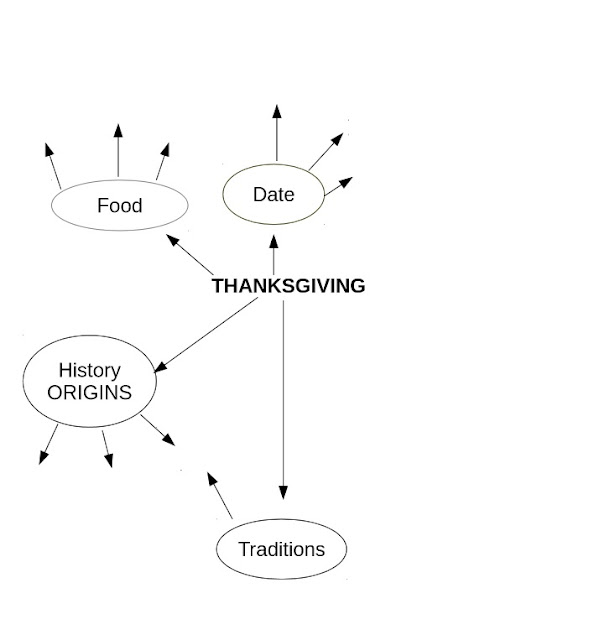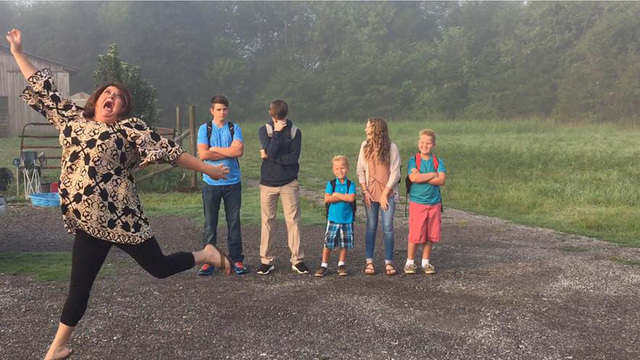4e Sequence 2: Happy Thanksgiving!
Bienvenue dans notre nouvelle séquence!
Aujourdh'ui, nous allons étudier une fête très importante aux USA: Thanksgiving. En avant!
DOCUMENT 1: Pour commencer, que savez-vous de Thanksgiving? Remplissez cette mindmap:
Si vous avez fini, vous pouvez consulter la correction ci-dessous:
Proposition de correction rapide par les 4*5:
"I can see Natives and Pilgrims. A woman gives food to a native man in the foreground/in the middle. On the right, there are one dog with a little girl. Women wear dresses and men wear cloaks.
In the background I can see the ocean. The Natives are semi-naked."
Proposition des 4*4:
"I can see water in the background : maybe it is the ocean, or the sea, or a lake. There are Natives with Pilgrims (les pèlerins). They are sharing food and gifts ! I can see a dog, there are soldiers (les soldats). On the right, there is a table with a lot of/plenty of food/ there is a plethora of food. There is a house in the background. They are outside."
Origins of thanksgiving:
Aujourdh'ui, nous allons étudier une fête très importante aux USA: Thanksgiving. En avant!
DOCUMENT 1: Pour commencer, que savez-vous de Thanksgiving? Remplissez cette mindmap:
Si vous avez fini, vous pouvez consulter la correction ci-dessous:
DOCUMENT 2: Apprendre à décrire une image:
Vocabulaire de la description d'image:
en haut = at the top
en bas = at the bottom
à gauche = on the left
à droite= on the right
premier plan = foreground
arrière plan = background
Essayez de décrire cette image le plus précisément possible
"I can see Natives and Pilgrims. A woman gives food to a native man in the foreground/in the middle. On the right, there are one dog with a little girl. Women wear dresses and men wear cloaks.
In the background I can see the ocean. The Natives are semi-naked."
Proposition des 4*4:
"I can see water in the background : maybe it is the ocean, or the sea, or a lake. There are Natives with Pilgrims (les pèlerins). They are sharing food and gifts ! I can see a dog, there are soldiers (les soldats). On the right, there is a table with a lot of/plenty of food/ there is a plethora of food. There is a house in the background. They are outside."
Origins of thanksgiving:
THANKS - GIVING
= merci/donner.
DOCUMENT 3: video
Mais pourquoi ce choix de mots? que signifie-t-il? Qui a donné quoi à qui?
Mais pourquoi ce choix de mots? que signifie-t-il? Qui a donné quoi à qui?
Pour le savoir, clique sur le lien suivant pour regarder la vidéo :
The History of Thanksgiving Day
Qu'en as-tu retenu?
GRAMMAIRE: le prétérit:
The History of Thanksgiving Day
Qu'en as-tu retenu?
GRAMMAIRE: le prétérit:
è Ce temps correspond à décrire des actions passées (dans un récit), qui sont achevées . On peut le comparer à l’imparfait, le passé composé et le passé simple .
- Construction : il y a 2 types de verbes :
- REGULIERS = on ajoute -ED/ -D à la fin du verbe
- IRREGULIERS = il faut les apprendre par <3
Dans les questions, les réponses courtes et dans les négations, on ajoute l’auxiliaire « DO », qui se dit « DID » au prétérit.
Exemples de phrases :
1) Affirmative : Sujet + V-ed// 2e col + complément : I played football.
2) Negative : Sujet + didn’t + BV + complément : you didn’t play football
3) Interrogative : Did + sujet + BV + complément ? :Did you play football ?
à Lorsqu’on a «DID » à la négative et l’interrogative, le verbe RESTE A LA BASE VERBALE (non conjugué)
Exercices prétérit:
WAS ou WERE ?
1. She is thirty now, so last
year she .................... twenty-nine.
2. .................... it a good film?
3. I got married when I .................... twenty-seven.
4. It .................... a great day, but we .................... so tired!
5. I didn't buy those jeans because they .................... too expensive.
6. When I .................... a child we lived in Rome.
7. Where .................... you yesterday afternoon?
2. .................... it a good film?
3. I got married when I .................... twenty-seven.
4. It .................... a great day, but we .................... so tired!
5. I didn't buy those jeans because they .................... too expensive.
6. When I .................... a child we lived in Rome.
7. Where .................... you yesterday afternoon?
Conjuguez
les verbes au prétérit simple
1. The concert
__________ (be) great. I really __________ (enjoy) it.
2. _______________________
(you / have) a nice weekend in London?
3. She
_______________ (not / like) the food. It was horrible.
4. Which
museum _____________________(you / go) to ?
5. Yesterday
we ________________ ( go) to Paris and we __________ (pay) a visit to Jane.
6. They
_________________ (pass) their exam last year. They __________ (be) very happy.
7. I
_____________ (see) her five minutes ago!
8. They
_______________ (not / win) the game. What a shame!
9. She
_________________(do) some shopping but I didn't. I ___________________ (not /
want) to queue at shops.
10. You
_______________ (not / be) in very good health. That's why you __________
(lose) the match.
11. Sophie
_______________ (be) ill yesterday. She ____________ (stay) in bed all
day.
12. The house
_____________ (burn) completely. The fire brigade ___________________ (not /
arrive) on time.
******
Mais que savez-vous au juste sur thanksgiving? Avez-vous quelques souvenirs de la vidéo vue au début du chapitre? Pour le savoir, remplissez la fiche ci-dessous!
DOCUMENT 4: a history of thanksgiving.
 3. The Natives feel:
3. The Natives feel: Positive about thanksgiving Negative about thanksgiving
Positive about thanksgiving Negative about thanksgiving
DOCUMENT 4: a history of thanksgiving.
A présent, il serait intéressant de s'intéresser à cette celebration du point de vue des Amérindiens. Que pensent-ils, eux, de ce jour? Pour le découvrir, regarder la vidéo suivante:
Tentez maintenant de répondre aux questions qui suivent en vous aidant de la vidéo.
The
Meaning Of Thanksgiving For Native Americans:
è Watch and listen to the video, and answer the following questions:
1. Who is
talking in the video?
____________________________________________________________
2. What
does the old woman call “thanksgiving”?
___________________________________________________________
Find
examples which explain how the Natives feel about thanksgiving
-
-
-
4. Do the
Natives celebrate Thanksgiving?
____________________________________________________________________________________________________________________________________
Now, listen
to the video again: what are the 2 important messages the Natives want to
spread (spread=propager)?
-
-
 |










Comments
Post a Comment